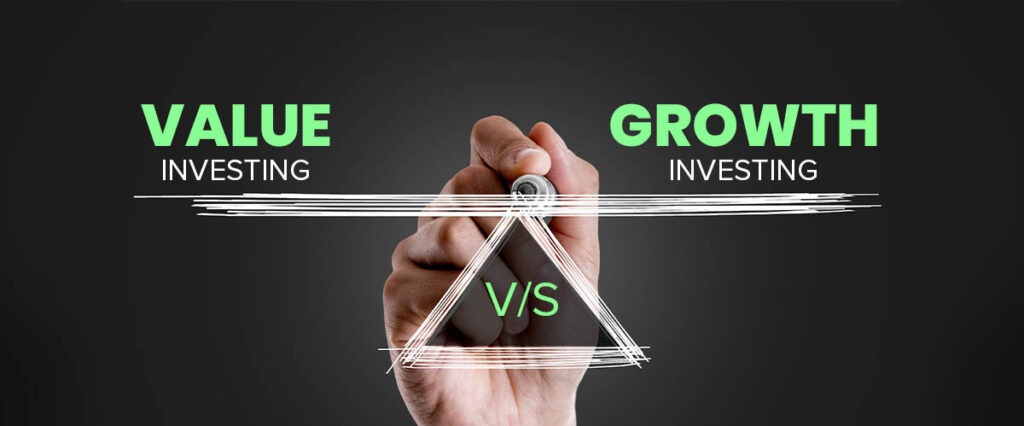
Investors need to employ diverse methods to optimize their profits as markets are always prone to fluctuation. Growth and Value investing are the two popular methods of fundamental investing. In this blog, we will analyze these techniques and how they can be used. Both strategies offer unique advantages and cater to different types of investors. Understanding these strategies and knowing when to apply them can help you make informed decisions.
What is Value Investing?
Value investing is a strategy in investment where stocks or other financial assets are chosen because they are believed to be undervalued by the market.
The idea of value investing became widely known thanks to Benjamin Graham and David Dodd in their 1934 book “Security Analysis” and later by Warren Buffett, a highly successful follower of this strategy.
The basic concept of value investing is to purchase assets for less than their true worth by examining different financial metrics like earnings, book value, dividends, and cash flow.
Key Principles of Value Investing Include:
- Intrinsic worth: Value investors strive to determine the intrinsic worth of a financial asset, which reflects its actual value stemming from its core fundamentals and anticipated cash flows.
- Margin of safety: Margin of safety is a crucial idea in the field of value investing. It refers to purchasing an asset below its estimated intrinsic value, offering protection against valuation mistakes or market downturns.
- Long-term perspective: Value investors usually look at the long-term picture, expecting the market to eventually acknowledge an asset’s true value and drive its price up.
What is Growth Investing?
Growth investing involves investors predicting that specific growth companies will grow at an attractive rate compared to others.
Investors anticipate consistent and substantial growth in earnings, sales, book value, and cash flow. Growth Stocks can be easily found in the share market today.
These companies succeed over competitors by offering innovative products and pricing strategies, all while maintaining a solid financial foundation.
Key Principles of Growth Investing Include:
- High valuation tolerance: Growth stocks are often priced higher than their current earnings or book value because investors are prepared to pay a premium for the anticipated future growth. Growth investors are usually more accepting of higher price-to-earnings (P/E) ratios and other valuation measures.
- Focus on potential for expansion: Investors focused on growth prioritize companies with strong potential for growth in sales, earnings, and cash flow. These companies frequently work in swiftly growing sectors or offer groundbreaking products or services that can shake up the market.
- Long-term investment strategy: Growth investing, similar to value investing, usually involves a long-term view. Growth investors have confidence that the companies they invest in will keep expanding and providing worth in the long run, despite possible temporary changes in stock prices.
Difference Between Value Investing and Growth Investing
| Aspect | Value Investing | Growth Investing |
| Definition | Investing in undervalued stocks believed to be trading below their intrinsic value. | Investing in stocks of companies expected to grow at an above-average rate compared to others. |
| Focus | Stocks that are undervalued by the market. | Stocks with high growth potential. |
| Key Metrics | Price-to-Earnings (P/E) ratio, Price-to-Book (P/B) ratio, Dividend Yield. | Earnings Growth Rate, Revenue Growth, Return on Equity (ROE). |
| Investment Horizon | Long-term, as it may take time for the market to recognize the true value of the stock. | Can be both short-term and long-term, depending on growth trends. |
| Typical Sectors | Often found in mature industries such as finance, utilities, and manufacturing. | Commonly found in technology, biotech, and emerging sectors. |
| Investor Profile | Conservative investors looking for stability and income. | Investors seek high returns through capital appreciation. |
Growth vs. Value Investing: Which is the Better Approach?
Investment decisions are influenced by factors such as risk tolerance, financial goals, time horizon, and individual preferences. Therefore, there is no universally “right” or “wrong” approach to stock selection, as advocates of both strategies can present valid arguments for their preferences.
Investors have the option to create a diversified portfolio that includes both growth and value stocks.
When crafting your portfolio, it is essential to understand the strengths and weaknesses of both growth and value investing. This knowledge will help you make informed decisions and tailor your investment strategy to your specific needs and objectives.
Final Words
Value investing and growth investing offer distinct pathways to financial success in the share market today. Your decision should align with your financial objectives, risk appetite, and investment timeline. By understanding the core principles and leveraging the best investing platform, you can make informed choices that pave the way for a prosperous investment journey.
